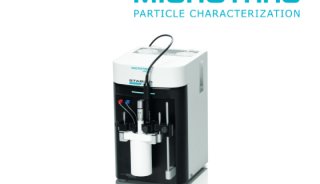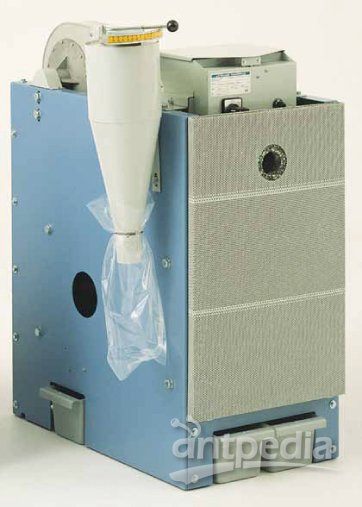病毒颗粒的等电位滴定曲线用于指导离子交换层...(三)
使用毛细管等电聚焦分析5型AV的稳定性已被描述[17] 。然而,这是首次被描述的使用电泳滴定曲线测定完整病毒颗粒的电荷行为。
也采用ETC对经320nm紫外线照射15分钟灭活的麻疹病毒进行了分析。琼脂糖凝胶电泳曲线证实在PH值低于7时病毒带正电荷,在pH值高于7时带负电荷(图3)。然而,在pH值高于7时,持续存在严重的聚集问题。根据在PH值高于7时对未灭活的麻疹病毒进行的实验,聚集问题看似是常见的,并且不是由于紫外线照射处理所致。然而,紫外线交联可能增加聚集。
根据ETC的结果,选择阳离子交换法分离麻疹病毒。该方法选择也通过污染物的电泳分析法证实,电泳分析法证实大量污染物在pH > 5.5时带负电荷(图4)。这有点意外,因为麻疹病毒两种包膜蛋白的等电点表明该病毒在pH值高于5.5时应该是带负电荷[18-20] 。这些观察结果表明以经验为主而不是基于蛋白质序列或个别蛋白质等电点来确定电荷性质的有用性。在此基础上,选用pH值为6.5的条件,SP Sepharose XL成功的纯化了麻疹病毒(图5)。
离子交换层析也可应用于腺相关病毒(AAV)、鼠白血病病毒和细菌噬菌体如lambda 和M13的纯化(数据未列出)。AAV的分析表明:在pH值高于7时,整体净电荷为负,并且在低于中性pH时整体净电荷为正。污染物在pH为5-5.5以上时看似像带负电荷。使用SP Sepharose High Performance从细胞溶解产物中纯化AAV,再利用SOURCE™ 30 Q精细纯化纯化效果较好[21]。
莫洛尼小鼠白血病病毒在pH高于6时表现出整体净负电荷,在pH低于6时为净正电荷。这与已描述的表面蛋白的等电点相一致(22–25)。在高于和低于那个pH时,电荷以快速增加的偏移速度急剧转换。污染物看似在pH值为5–5.5以上时也是主要带负电荷,然而,在5.5–8的pH值范围内电荷轻度增加。RESOURCE Q上的阴离子交换层析用于分离MLV与它的主要污染物(数据未列出)。

层析柱:Q Sepharose XL HR 5/5 层析柱
样品:灭活麻疹病毒
进样体积:2.4 ml,置于缓冲液 A 中
缓冲液 A:25 mM 磷酸钠(pH 6.5)
缓冲液 B:缓冲液 A+1M NaCl
梯度:步骤 1 中的 0-100%缓冲液 B
流速:75 cm/h(0.25ml/min)
系统:ÄKTAexplorer 10
检测波长:260 和 280 nm
图5、在pH 6.5下在SP Sepharose XL中对紫外线灭活麻疹病毒所进行的分离。 黑线所示为含有病毒的组分(基于凝胶过滤分析数据)。
结论
电泳滴定曲线是一种用于初步筛选病毒颗粒的离子交换层析条件的简单、快速的方法。此处描述的该方法依靠CyDye标记和使用Typhoon扫描仪观察,用于病毒颗粒的快速和敏感的检测。 如上所述, ETC被用于确定一个适当的pH范围以进行完整病毒颗粒的离子交换层析。在某些情况下,仅能依靠经ETC电泳滴定产生的经验数据来确定适当的pH范围,而已经发表的衣壳蛋白质的等电点并不适用于确定病毒纯化条件。
参考文献
1. Lindblom, H. et al. Separation of urine proteins on the anion-exchange resin mono Q. J. Chromatogr. 273,107–116 (1983).
2. Nath, S. et al. Correlation of migration behavior in free-flow zone electrophoresis and electrophoretic titration curve. Electrophoresis, 11, 612–616 (1990).
3. Avellana-Adalid, V. et al. Electrophoretic study of conformational changes of a human soluble beta-D-galactoside-binding lectin upon storage. Electrophoresis, 13, 416–421 (1992).
4. Hull, H. H. and Wharton, D. C. Isoelectrophoretic characterization of Pseudomonas cytochrome oxidase/nitrite reductase and its heme d1-containing domain. Arch. Biochem. Biophys. 301, 85–93 (1993).
5. Brisabois, A. and Gullet, P. Isolation and characterization of carboxylesterase E3 from Salmonella enterica. J. Appl. Bacteriol. 75, 176-183 (1993).
6. Picard, B. et al. Genetic heterogeneity of Pseudomonas aeruginosa clinical isolates revealed by esterase electrophoretic polymorphism and restriction fragment length polymorphism of the ribosomal RNA gene region. J.Med. Microbiol. 40, 313–322 (1994).
7.Watanabe, E. et al. Selection of chromatographic protein purification operations based on physicochemical properties. Ann. N Y Acad. Sci., 721, 348-364 (1994).
8. Attanasio, F. et al. Analytical titration curves of glycosyl hydrolase Cel45 by combined isoelectric focusing-electrophoresis. Electrophoresis, 20, 1403-1411 (1999).
9. Ameskamp, N. et al. Pilot scale recovery of monoclonal antibodies by expanded bed ion exchange adsorption. Bioseparation 8, 169-188 (1999).
10. Sanchez, E. E. et al. Partial characterization of a basic protein from Crotalus molossus molossus (northern blacktail rattlesnake) venom and production of a monoclonal antibody. Toxicon 39, 523-529 (2001).
11. O'Riordan, C. A. et al. Scaleable chromatographic purification process for recombinant adeno-associated virus (rAAV). J. Gene Med. 2, 444-454 (2000).
12. Gao, G. et al. Purification of recombinant adeno-associated virus vectors by column chromatography and its performance in vivo. Hum. Gene Ther. 11, 2079-2091 (2000).
13. Tamayose, K., et al. A new strategy for large-scale preparation of high-titer recombinant adeno-associated virus vectors by using packaging cell lines and sulfonated cellulose column chromatography. Hum. Gene Ther. 7, 507-513 (1996).
14. Huyghe, B. G. et al. Purification of a type 5 recombinant adenovirus encoding human p53 by column chromatography. Hum. Gene Ther. 11, 1403-1416 (1995).
15.Westermeier, R. Electrophoresis in Practice, 3rd ed., WILEY-VCH Verlag GmbH, Weinheim, (2001).
16. Adam, E. et al. Comparative studies on the soluble proteins of adenovirus type 1. Acta Microbiol Acad Sci Hung. 24, 181-187 (1977).
17. Mann, B. et al. Capillary zone electrophoresis of a recombinant adenovirus. J. Chromatogr. A 895, 329-337 (2000).
18. Kohama, T. et al. Maturation of measles virus hemagglutinin glycoprotein. Arch. Virol. 85, 257-268 (1985).
19. Boriskin, YuS. et al. Measles virus persistent infection: modification of the virus nucleocapsid protein. J. Gen. Virol. 67, 1979-1985 (1986).
20. Andzhaparidze, O. G. et al. Analysis of the possible mechanisms for the persistence of the vaccinal strain of the measles virus in a human cell culture. Vopr Virosol. 33, 338-342 (1988).
21. Brument, N. et al. A versatile and scalable two-step ion-exchange chromatography process for the purification of recombinant adeno-associated virus serotypes-2 and -5. Mol. Ther. 6, 678-686 (2002).
22. Strand, M. and August, J. T. Polypeptide maps of cells infected with murine type C leukemia or sarcoma oncovirus. Cell 13, 399-408 (1978).
23. Forchhammer, J. and Turnock, G. Glycoproteins from murine C-type virus are more acidic in virus derived from transformed cells than from nontransformed cells. Virology 88, 177-182 (1978).
24. Katoh, I. et al. Murine leukaemia virus p30 heterogeneity as revealed by two-dimensional gel electrophoresis is not an artefact of the technique. J. Gen. Virol. 65, 733-741 (1984).
25. Ikuta, K. and Luftig, R. B. Differences in the pI heterogeneity of virion and intracellular Moloney murine leukaemia virus p30s. J. Gen. Virol. 68, 487-498 (1987).




















